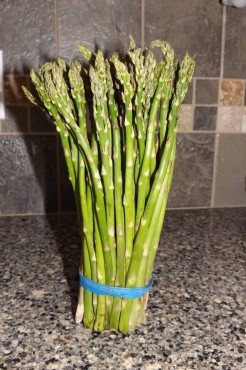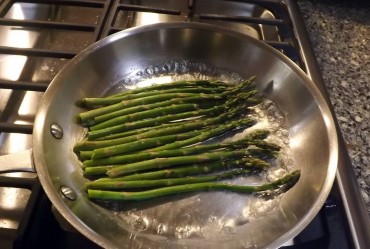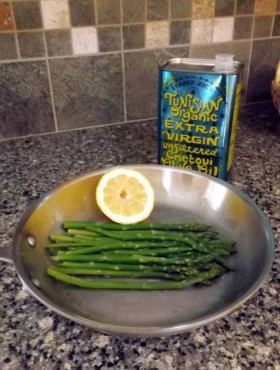
Fleshy, green and succulent, asparagus is the ultimate spring vegetable. Known for its cleansing diuretic properties for centuries and once only available in spring, it has become a year-round favorite on American tables.
Early culinary records indicate asparagus, which is a native of Europe, may have been eaten and used as an offering in Egypt as early as 3000 BC. History shows us that although the shoots are best enjoyed when fresh and tender in the early spring, early Greeks dried it for use in winter. According to Suetonius the Historian (69-140 AD), the Romans froze it in the Alps and used it for the Feast of Epicurus.
Most asparagus found in grocery stores and farmers markets in the USA is green in color, with the stems ranging in size from pencil thin to about 1/2 and inch in diameter. The larger stems indicate an older plant.
More common in Europe than here is the very large stemmed, white asparagus. As the shoots grow taller, soil is heaped up onto them to prevent exposure to sunlight, which causes the development to chlorophyll. Germans even celebrate the season of asparagus in “Spargelsaison.”
Restaurants offer whole meals based on various preparation methods for this interesting healthy vegetable. White asparagus is often served with a very rich hollandaise sauce.
Asparagus may be steamed, broiled, fried, grilled, boiled and roasted. It is delicious by itself with a minimum of seasonings and added ingredients, but can also be added to soups, quiche, omelets and, in raw form, to salads. Asparagus can also be preserved by pickling, drying and freezing.
The easiest, most healthful and quickest way to prepare cooked asparagus is by blanch-steaming in a small amount of water in a shallow skillet.

Asparagus 1
Wash asparagus and either break stems where they snap naturally, or cut off the bottom one inch or so, and use a vegetable peeler to take off the tough outer layer.
Place asparagus spears in skillet, add about 1/2 inch water and sprinkle lightly with salt.
Cover and bring to simmer over medium heat. Simmer about 3-5 minutes, depending on thickness of stems, until asparagus is bright green and tender when poked with a fork.
Drain off remaining water, if any. If serving as a side vegetable, drizzle with a little olive oil or melted butter, and squeeze a couple of teaspoons of fresh lemon juice over all. Add a little coarse finishing salt if desired. Serve hot.
Options:
Sprinkle with crumbled crisp bacon or grated parmesan cheese instead of oil and lemon.

Asparagus 2
Wash asparagus and either break stems where they snap naturally or cut off the bottom one inch or so, and use a vegetable peeler to take off the tough outer layer.
Heat 1 tablespoon good-quality olive oil and 1 tablespoon butter together until butter just starts to foam. Add 1 tablespoon coarsely chopped garlic.
Add 15-20 stalks of asparagus and sauté just until asparagus is bright-green and tender.
Remove to a warm plate, scraping garlic bits over asparagus and sprinkle with coarse sea salt.
Oven Braised Asparagus
Wash asparagus and either break stems where they snap naturally or cut off the bottom one inch or so, and use a vegetable peeler to take off the tough outer layer.
Heat oven to 400 degrees. Spread asparagus spears on cookie sheet or in a glass 9-by-13-inch dish.
Drizzle with olive oil, sprinkle salt and pepper over all, add crushed garlic if desired.
Place in hot oven and bake about 20-25 minutes until fork tender.
Serve hot or at room temperature.
























Comments